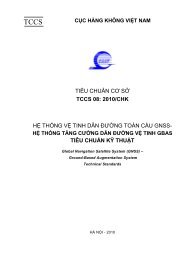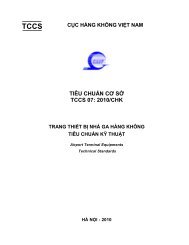AC 18-002 DG Manuals CAAV [A]2009.fm
AC 18-002 DG Manuals CAAV [A]2009.fm
AC 18-002 DG Manuals CAAV [A]2009.fm
You also want an ePaper? Increase the reach of your titles
YUMPU automatically turns print PDFs into web optimized ePapers that Google loves.
CIVIL AVIATION AUTHORITY<br />
OF VIETNAM<br />
ADVISORY CIRCULAR<br />
<strong>AC</strong>-<strong>18</strong>-<strong>002</strong><br />
GUIDANCE FOR DEVELOPMENT OF<br />
DANGEROUS GOODS MANUALS<br />
SECTION 1<br />
GENERAL<br />
1.1 PURPOSE<br />
This Advisory Circular (<strong>AC</strong>) provides specific guidance to organizations preparing their<br />
dangerous goods manuals for submission to the <strong>CAAV</strong> during certification for transport of<br />
dangerous goods by air.<br />
1.2 STATUS OF THIS ADVISORY CIRCULAR<br />
This is an original issuance of this <strong>AC</strong>.<br />
1.3 B<strong>AC</strong>KGROUND<br />
A. ICAO Standards in Annex <strong>18</strong>, Safe Transportation of Dangerous Goods by Air, require that<br />
Vietnam must complete an assessment of an individual, organization or entity before issuing<br />
an authorization allowing these entities to engage in the process of transportation of<br />
dangerous goods by air.<br />
B. In support of its international safety oversight obligations, Vietnam has safety legislation and<br />
guidance regarding the requirements that apply to the safe transportation of dangerous<br />
goods, including—<br />
1) VAR Part <strong>18</strong> and<br />
2) Dangerous goods advisory circulars<br />
C. Vietnam has established a certification process to ensure the completeness and<br />
standardization for the issuance of authorizations to transport dangerous goods by air.<br />
1.4 APPLICABILITY<br />
A. All organizations involved in the transport of dangerous goods by air are required to have an<br />
approved policy/procedures manual, or portions of manuals, to enable their personnel to<br />
safety accept, handle and transport these goods in accordance with ICAO Technical<br />
Inspections.<br />
B. All individuals involved in the process of transport of dangerous goods by air are required to<br />
have access to and use the approved guidance in the performance of their tasks.<br />
• Advisory Circulars are intended to priovide advice and guidance to illustrate a means, but not necessarily the only means, of<br />
complying with the Regulations, or to explain certain regulatory requirements by providing informative, interpretative and<br />
explanatory material.<br />
• Where an <strong>AC</strong> is referred to in a ‘Note’ below the regulation, the <strong>AC</strong> remains as guidance material,<br />
• <strong>AC</strong>s should always be read in conjunction with the referenced regulations.<br />
Issue Date: 31 October 2009
2<br />
<strong>AC</strong>-<strong>18</strong>-<strong>002</strong>: DANGEROUS GOODS MANUALS<br />
1.5 RELATED REGULATIONS<br />
The following regulations are directly applicable to the guidance contained in this advisory<br />
circular—<br />
• VAR Part <strong>18</strong>, Carriage of Dangerous Goods by Air<br />
1.6 RELATED PUBLICATIONS<br />
For further information on this topic, individuals, organizations and other entities are invited to<br />
consult the following publications—<br />
1) Civil Aviation Administration of<br />
Vietnam (<strong>CAAV</strong>)<br />
<br />
<br />
<strong>AC</strong> <strong>18</strong>-001, Process & Application:<br />
Transportation of Dangerous Goods by Air.<br />
<strong>AC</strong> <strong>18</strong>-003, Guidance for Development of Dangerous Goods Training Programs.<br />
2) International Air Transport Association (IATA)<br />
<br />
Dangerous Goods Regulations<br />
3) International Civil Aviation<br />
Organization (ICAO)<br />
<br />
<br />
Annex <strong>18</strong>, Safe Transportation of<br />
Dangerous Goods by Air<br />
Technical Instructions (TI)<br />
Copies may be obtained from the <strong>CAAV</strong> Flight<br />
Safety Standards Department.<br />
Copies may be obtained from Document Sales<br />
Unit, ICAO, 999 University Street, Montreal,<br />
Quebec, Canada H3C 5H7.<br />
1.7 DEFINITIONS & <strong>AC</strong>RONYMS<br />
1.7.1 DEFINITIONS<br />
A. The following definitions are used in this advisory circular—<br />
1) Dangerous goods. Articles or substances which are capable of posing a risk to health,<br />
safety, property or the environment when transported by air and which are classified<br />
according to the International Civil Aviation Organization Technical Instructions for the<br />
Safe Transport of Dangerous Goods by Air.<br />
2) Dangerous goods accident. An occurrence associated with and related to the<br />
transport of dangerous goods by air which results in fatal or serious injury to a person or<br />
major property damage.<br />
3) Dangerous goods incident. An occurrence, other than a dangerous goods accident,<br />
associated with and related to the transport of dangerous goods by air, not necessarily<br />
occurring on board an aircraft, which results in injury to a person, property damage, fire,<br />
breakage, spillage, leakage of fluid or radiation or other evidence that the integrity of the<br />
packaging has not been maintained. Any occurrence relating to the transport of<br />
dangerous goods which seriously jeopardizes the aircraft or its occupants is also<br />
deemed to constitute a dangerous goods incident.<br />
1) Hazardous chemical – Any chemical which has properties that present either physical<br />
or health hazards. Hazardous chemicals include both physical and health hazards.<br />
2) Hazardous materials – A substance or material which is capable of posing an<br />
unreasonable risk to health, safety and property when transported. (See also the<br />
definition of “dangerous goods.”) There are nine international assigned classes of<br />
dangerous goods, which are discussed in Chapter 13.<br />
Issue Date: 31 October 2009
<strong>AC</strong>-<strong>18</strong>-<strong>002</strong>: DANGEROUS GOODS MANUALS<br />
3<br />
3) Hazardous Occurrence: accident or other occurrence arising in the course of or in<br />
connection with the employee’s work that has caused or is likely to cause injury to that<br />
employee or to any other person<br />
4) Hazardous waste – A discarded substance that because of its quantity, concentration,<br />
physical, chemical or infectious characteristics may cause or contribute to a serious<br />
illness or pose a substantial or potential hazard to human health or the environment<br />
when improperly treated, stored, transported or disposed of.<br />
1.7.2 <strong>AC</strong>RONYMS<br />
The following acronyms are used in this manual—<br />
1) AOC – Air Operator Certificate<br />
2) COMAT – Company Materials<br />
3) <strong>DG</strong> – Dangerous Goods<br />
4) <strong>DG</strong>C – Dangerous Goods Coordinator<br />
5) <strong>DG</strong>R – IATA Dangerous Goods Regulations<br />
6) IAEA – International Atomic Energy Agency.<br />
7) IATA – International Air Transport Association<br />
8) ICAO – International Civil Aviation Organization<br />
9) ICAO-TI’s – International Civil Aviation Organization Technical Instruction for the Safe<br />
Transport of Dangerous Goods by Air.<br />
10) NOTOC – Notification to the Captain<br />
1.8 GENERAL MANUAL REQUIREMENTS<br />
A. The operator’s Dangerous Goods Manual must detail the proper procedures for dealing with<br />
the carriage of dangerous goods on board the operator’s aircraft.<br />
B. The nature of the operation and the operator’s policy on what classes or quantities of<br />
dangerous goods will be accepted for carriage will dictate the type of information and/or the<br />
level of detail that needs to be published for the information of employees.<br />
OPS 4.365<br />
SECTION 2<br />
OPERATORS WHO DO NOT TRANSPORT DANGEROUS GOODS<br />
Operators who do not accept, handle, or store dangerous goods must provide procedures and<br />
instructions in the operator’s manual as follows—<br />
1) Procedures and instructions so that all<br />
personnel responsible for accepting<br />
and handling any cargo or packaged<br />
materials receive adequate training on<br />
the recognition of items classified as<br />
dangerous goods;<br />
Adequate, as used here, is defined in an operational<br />
sense to mean the demonstrated ability<br />
of required personnel to identify such items.<br />
2) Procedures and instructions to ensure that no packages are accepted by the operator<br />
containing a dangerous good;<br />
3) Procedures and instructions for reporting that damaged packages found to contain, or<br />
that are suspected of containing, dangerous goods or dangerous goods are reported in<br />
compliance with VAR Part <strong>18</strong>;<br />
Issue Date: 31 October 2009
4<br />
<strong>AC</strong>-<strong>18</strong>-<strong>002</strong>: DANGEROUS GOODS MANUALS<br />
4) Procedures and instructions to see that all company material (COMAT) containing<br />
dangerous goods will be offered to a different mode of transportation (e.g., ground) and/<br />
or an operator that is authorized to transport dangerous goods; and<br />
5) Procedures and instructions to see that any employee, agent, or contract employee of<br />
the operator who prepares and/or offers COMAT containing dangerous goods for<br />
shipment via any mode is fully trained as a dangerous goods shipper.<br />
SECTION 3<br />
OPERATORS WHO <strong>AC</strong>CEPT DANGEROUS GOODS FOR TRANSPORT<br />
Operators who transport dangerous goods must complete a dangerous goods certification<br />
process that includes the submission of an acceptable manual containing the policies and<br />
procedures included in this Section.<br />
3.1 REFERENCE TO REQUIREMENTS<br />
The manual must contain references to the regulatory requirements, to include—<br />
1) A listing and explanation of the applicable Vietnam legislation covering consignment and<br />
carriage of dangerous goods<br />
2) A listing and explanation of the applicable technical documents relating to dangerous<br />
goods matters and their location<br />
3) An policy statement emphasizing the need to comply with the company policy and<br />
procedures detailed in the manual.<br />
3.2 RESPONSIBILITIES OF COMPANY PERSONNEL<br />
The company dangerous goods manual shall be specific regarding the responsibilities of their<br />
personnel—<br />
1) For keeping the dangerous goods manual amended and up to date<br />
2) For acquiring and distributing reference materials and documentation (e.g., IATA <strong>DG</strong>Rs,<br />
checklists etc)<br />
3) For ensuring that employees maintain currency in <strong>DG</strong> training and that records are up to<br />
date<br />
4) For ensuring that agents and other deemed employees are trained, maintain currency in<br />
training and that records are up to date.<br />
3.3 COMPANY POLICY FOR SPECIFIC <strong>DG</strong> THAT MAY BE TRANSPORTED<br />
The company dangerous goods manual shall be specific regarding the—<br />
1) Dangerous goods which may not be carried<br />
2) Dangerous goods of the Operator (COMAT) and their handling<br />
3) Dangerous goods which may be carried on special operations (e.g. air ambulance,<br />
tactical law enforcement, incendiary dropping, search and rescue, etc.)<br />
4) Operator variations<br />
5) Existing <strong>CAAV</strong> exemptions, deviations and waivers relating to dangerous goods that<br />
have been granted to the company.<br />
Issue Date: 31 October 2009
<strong>AC</strong>-<strong>18</strong>-<strong>002</strong>: DANGEROUS GOODS MANUALS<br />
5<br />
3.4 DANGEROUS GOODS CARRIED BY PASSENGERS AND CREW<br />
The company dangerous goods manual shall be specific regarding the—<br />
1) Dangerous goods which passengers<br />
are permitted to have in carry-on<br />
baggage, on their person, and in their<br />
checked baggage.<br />
This must include the procedures and responsibilities<br />
for obtaining and granting operator<br />
approval for those items that may only be carried<br />
with the approval of the operator.<br />
2) Provision of information to passengers<br />
at passenger check-in points, ticketing areas, baggage collection areas etc.<br />
3) Disposal of dangerous goods confiscated on the aircraft, on the ground or in flight.<br />
OPS 4.347<br />
OPS 4.347<br />
OPS 4.347<br />
3.5 DANGEROUS GOODS <strong>AC</strong>CEPTANCE PROCEDURES<br />
A. The company dangerous goods manual shall be have and require the use of an acceptance<br />
checklist to prevent acceptance of <strong>DG</strong> for transport by air unless the package complies with<br />
the ICAO-TI.<br />
B. Additionally, the company dangerous goods manual shall be specific regarding the—<br />
1) Employees authorised to accept<br />
dangerous goods on behalf of the<br />
operator (this may be expressed by<br />
name or position title).<br />
2) Acceptance procedures;<br />
3) Evaluation of the accompanying dangerous goods transport documents<br />
4) Inspection of the—<br />
(a) Marking’<br />
(b) Packaging;’<br />
(c) Overpack; and/or<br />
(d) Freight container.<br />
5) Rejection processes<br />
6) Methods to aid the identification of hidden and/or mis-declared dangerous goods<br />
<br />
<br />
Common mis-declared items<br />
Requirements for consignor of cargo to make a signed statement of contents of cargo<br />
7) Procedures for reporting discrepancies with the loading or the shipper’s papers<br />
8) Acceptable documentation of dangerous goods—<br />
<br />
<br />
<br />
Checklists<br />
NOTOCs<br />
Freight manifests<br />
Where the responsibility is contracted to an<br />
agent, a reference to that agent should be<br />
made.<br />
OPS 4.347<br />
3.6 P<strong>AC</strong>KAGE EVALUATION<br />
The company dangerous goods manual shall be specific regarding—<br />
1) Acceptable packaging requirements—<br />
(a) The material must be properly packaged in accordance with the packaging rules and<br />
it must be properly marked, labeled, and documented.<br />
Issue Date: 31 October 2009
6<br />
<strong>AC</strong>-<strong>18</strong>-<strong>002</strong>: DANGEROUS GOODS MANUALS<br />
(b) The total quantity must be within the quantity limitations and the shipment must be<br />
accompanied by the proper shipping papers and <strong>CAAV</strong> or competent authority<br />
certificates, as determined by the inspection requirements for accepting shipments.<br />
2) Procedures to ensure that the package is damage-free<br />
<br />
The package may not leak or be damaged, and must be an authorized package in accordance<br />
with the applicable regulations and Technical Instructions.<br />
3) Procedures to ensure that the package is properly authorized for transport by air.<br />
<br />
The package must either be authorized for transport in passenger-carrying aircraft or, if it is not<br />
acceptable for such aircraft, clearly labeled for cargo-only aircraft<br />
4) Procedures to ensure that the package and its contents are properly identified.<br />
<br />
The material must be identified by the proper shipping name, hazard class or division, identification<br />
number, and packing group, when required, in accordance with ICAO Technical<br />
Instructions.<br />
5) Procedures to ensure that the package is properly marked and labeled in accordance<br />
with the ICAO-TI.<br />
6) Procedures for review of shipping papers to ensure that all necessary information is<br />
entered, including any additional information that may be required because of the<br />
commodity shipped, or because the method of transportation is related to air<br />
transportation.<br />
OPS 4.349<br />
3.7 STORAGE & HANDLING<br />
The company dangerous goods manual shall be specific regarding the—<br />
1) Procedures for accepting and storing cargo, including dangerous goods)<br />
2) Retention of documentation<br />
3) Segregation, storage and handling<br />
4) Procedures for storage of Class 8 (corrosive) materials to prevent these materials from<br />
being stored next to, or in contact with, Class 4, Division 4.2 or 4.3 (flammable) solids or<br />
Class 5, Division 5.1 (oxidizing) materials must be prevented.<br />
5) Procedures for storing any packages containing dangerous goods that might react<br />
dangerously when stored in a position that causes or contributes to leakage.<br />
6) Procedures for storing Class 7 (radioactive) materials to include—<br />
(a) Ensuring that the storage of Class 7 (radioactive) materials labeled yellow II and/or<br />
yellow III will not exceed a transport index (TI) of 50 in a single storage location.<br />
(b) Ensuring that these materials are stored in an area that is isolated from people and<br />
does not permit pedestrian traffic or loitering.<br />
(c) Maintaining the minimum separation distances prescribed in the Technical<br />
Instructions between radioactive materials labeled yellow II and yellow III and<br />
packages of undeveloped film.<br />
7) Procedures to ensure that packages bearing a Class 6, Division 6.1 toxic substance<br />
label will not be stored in the same location as foodstuffs, feeds, or any edible materials<br />
intended for consumption by either humans or animals.<br />
Issue Date: 31 October 2009
<strong>AC</strong>-<strong>18</strong>-<strong>002</strong>: DANGEROUS GOODS MANUALS<br />
7<br />
OPS 4.349<br />
OPS 4.349<br />
OPS 4.349<br />
OPS 4.351<br />
OPS 4.353<br />
3.8 COMPANY AIRCRAFT LOADING INSTRUCTIONS<br />
The company dangerous goods manual shall be specific regarding the loading of dangerous<br />
goods, including—<br />
1) Aircraft hold diagrams location and numbering system<br />
2) Inspection requirements for damage or leakage;<br />
3) Aircraft loading and unloading procedures, including measures to ensure that “Cargo<br />
Aircraft Only” packages of dangerous goods are not loaded onto passenger aircraft<br />
4) Stowage locations and quantities for radioactive substances (transport index limits), dry<br />
ice and magnetized material<br />
5) Segregation requirements<br />
6) Operator-specific requirements considering the nature of the hazard presented by<br />
certain classes of dangerous goods and the specific aircraft configuration (e.g., not<br />
storing corrosives next to emergency oxygen bottles or primary control cables)<br />
7) Potential hazards associated with each class<br />
<br />
<br />
Emergency action in the event of fire, spills or leakages<br />
First aid<br />
8) Loading of dangerous goods in aircraft in accordance with VAR Part<strong>18</strong>.<br />
9) Loading and carriage of dangerous goods in cargo-only aircraft, when other means of<br />
transportation are not available or impracticable, in accordance with the Technical<br />
Instructions<br />
10) Loading of radioactive materials in aircraft must be in accordance with the provisions of<br />
the Technical Instructions for transport of these packages.<br />
11) Loading of dangerous goods in cargo compartments or freight containers within cargo<br />
compartments, in accordance with VAR Part <strong>18</strong> and the Technical Instructions<br />
12) A prohibition against loading packages bearing a poison label in the same compartment<br />
that holds foodstuffs, feeds, or any edible materials intended for consumption by humans<br />
or animals unless both commodities are in separate, closed-unit load devices known as<br />
freight containers.<br />
3.9 NOTIFICATION TO CAPTAIN [NOTOC]<br />
The company dangerous goods manual shall be specific regarding the notification of the PIC<br />
when dangerous goods are carried on board the aircraft in accordance with VAR Part <strong>18</strong>,<br />
including—<br />
1) Responsibilities of load planners to ensure that the pilot in command has been notified of<br />
the presence, location and possible dangers of any dangerous goods loaded on the<br />
aircraft.<br />
2) Method of providing the written advice to pilot in command of <strong>DG</strong> location on board the<br />
aircraft<br />
3) Responsibilities of the pilot-in-command to acknowledge advice<br />
4) Procedures to have the NOTOC information for each flight on which dangerous goods<br />
are carried readily available to ground personnel during the flight by—<br />
(a) Retaining a copy of the NOTOC at the departure airport; and<br />
Issue Date: 31 October 2009
8<br />
<strong>AC</strong>-<strong>18</strong>-<strong>002</strong>: DANGEROUS GOODS MANUALS<br />
(b) Transmitting a copy of the NOTOC to the intermediate and destination airports prior<br />
to the expected time of arrival at those airports.<br />
3.10 EMERGENCY PROCEDURES<br />
The company dangerous goods manual shall be specific regarding the—<br />
1) Actions to be taken by employees in the event of an incident such as a spillage or<br />
leakage, on the ground or in-flight;<br />
2) In-flight emergency response information;<br />
3) Method of providing emergency response information to the pilot in command;<br />
4) Instructions to pilot in command to report to ATS details of dangerous goods carried, in<br />
the event of an in-flight emergency;<br />
5) Methods to be used to convey information to emergency services and to appropriate<br />
authorities in the event of an incident or accident of an aircraft carrying dangerous<br />
goods.<br />
OPS 4.355<br />
OPS 4.369<br />
3.11 DAMAGE TO DANGEROUS GOODS P<strong>AC</strong>KAGES<br />
The company dangerous goods manual shall be specific regarding the—<br />
1) Procedures for handling—<br />
(a) Damaged packages,<br />
(b) Radioactive contamination, and<br />
(c) Substances in Class 6, Division 6.2 (infectious substances).<br />
2) Contact information (list of telephone number, addresses and emails) for organizations<br />
that can provide technical advice on—<br />
(a) Clean-up techniques. and<br />
(b) Precautions to minimize the possibility of injury to employees and the general public.<br />
3.12 PROCEDURES FOR REPORTING DANGEROUS GOODS INCIDENTS<br />
The company dangerous goods manual shall be specific regarding the—<br />
1) Definition of a dangerous goods incident;<br />
2) Initial action;<br />
3) Follow-up action;<br />
4) Responsibility of employees to report; and<br />
5) Procedures for reporting dangerous goods incidents, in compliance with Section <strong>18</strong>.040.<br />
SECTION 4<br />
COMPANY DANGEROUS GOODS TRAINING<br />
The company dangerous goods manual (or a separate manual that is a part of the flight safety<br />
documents system) shall be specific regarding the—<br />
1) Training requirements for its personnel and service providers;<br />
2) Who is to be trained to what level and how often;<br />
3) Approved training organization(s) that may be used;<br />
OPS 4.367<br />
Issue Date: 31 October 2009
<strong>AC</strong>-<strong>18</strong>-<strong>002</strong>: DANGEROUS GOODS MANUALS<br />
9<br />
4) Curriculums that may be used;<br />
5) Operator-specific material to be covered by employees who attend a generic external<br />
course;<br />
6) Recording of training qualifications; and<br />
7) Retention of training records.<br />
SECTION 5<br />
QUALITY ASSURANCE & AUDITING<br />
5.1 AUDIT POLICIES & CHECKLISTS<br />
The company dangerous goods manual shall be specific regarding the—<br />
1) Responsibility for quality assurance of the dangerous goods acceptance, storage,<br />
loading and transportation process.<br />
2) Auditing checklists to be used to evaluate each phase of the process from—<br />
(a) Original packaging of the dangerous goods<br />
(b) Completion of shipping papers<br />
(c) Acceptance or rejection at the airline<br />
(d) Storage and handling<br />
(e) Loading in shipping containers<br />
(f) Loading on the aircraft<br />
(g) Notification of pilot in command<br />
(h) In-flight operations<br />
(i) Any in-flight incidents regarding a dangerous goods shipment \\<br />
(j) Any ground incidents, including leakage or storage location<br />
(k) Training records and completion of all requirements<br />
(l) Reporting of dangerous goods incidents<br />
5.2 AUDIT CYCLE & RESOLUTION POLICIES<br />
A. The companies or individuals that shall be audited on a 12-month cycle, to include all service<br />
providers, agents and company personnel that are involved in the process for shipping<br />
dangerous goods by air.<br />
B. The results of those audits including the actions taken to correct all audit findings.<br />
C. The retention of those audit and follow-up records for at least 24 calendar months.<br />
The Remainder Of This Page Intentionally Left Blank – Appendix Follows<br />
Issue Date: 31 October 2009
10<br />
<strong>AC</strong>-<strong>18</strong>-<strong>002</strong>: DANGEROUS GOODS MANUALS<br />
APPENDIX A<br />
<strong>DG</strong> Manual Conformance Checklist<br />
YES NO NS NA 1 LEGISLATION & OTHER DOCUMENTS<br />
1.1 Does the manual have a listing of the applicable Vietnam legislation<br />
covering consignment and carriage of dangerous goods?<br />
1.2 Does the manual have a listing of the applicable technical documents<br />
relating to dangerous goods matters and their location?<br />
1.3 Does the manual have policy emphasizing the need to comply with<br />
company policy and procedures in the <strong>DG</strong> manual?<br />
YES NO NS NA 2 GENERAL POLICIES<br />
2.1 Does the manual have policy guidance for dangerous goods that<br />
may not be carried?<br />
2.2 Does the manual have policy guidance for COMAT dangerous goods<br />
and how they will be handled?<br />
2.3 Does the manual have policy guidance for dangerous goods that<br />
may be carried on special operations?<br />
2.4 Does the manual have policy guidance regarding differences that<br />
are applicable to dangerous goods carriage on different types and<br />
variants of aircraft?<br />
2.5 Does the manual have policy guidance that explains all exemptions,<br />
deviations or waivers issued to the operator regarding the<br />
carriage of dangerous goods?<br />
2.6 Does the manual identify the employees (by name and title) that<br />
are authorized for to accept dangerous goods for the operator?<br />
2.7 If applicable, does the manual identify the agents (by company,<br />
name and title) that are authorized for to accept dangerous goods<br />
on behalf of the operator?<br />
YES NO NS NA 3 COMPANY POLICY & PROCEDURES<br />
3.1 Does the manual contain procedures for accepting and storing<br />
cargo (including dangerous goods?<br />
3.2 Does the manual contain methods to aid the identification of hidden<br />
and/or mis-declared dangerous goods?<br />
3.2 Does the manual contain guidance identifying the common misdeclared<br />
items?<br />
3.3 Does the manual contain requirements for consignor of cargo to<br />
make a signed statement of contents of cargo?<br />
3.4 Does the manual contain acceptance procedures and rejection processes<br />
procedures for dangerous goods?<br />
3.5 Does the manual contain dangerous goods handling checklists for<br />
each individual involved in the process to ensure safe acceptance?<br />
3.6 Does the manual contain instructions for the use and completion of<br />
the freight manifests and shipper’s papers to ensure proper processing<br />
and handling of dangerous goods?<br />
3.7 Does the manual contain instructions the use and completion of the<br />
the acceptance checklists, NOTOCS, and related documents?<br />
Issue Date: 31 October 2009
<strong>AC</strong>-<strong>18</strong>-<strong>002</strong>: DANGEROUS GOODS MANUALS<br />
11<br />
3.8 Does the manual contain policies and procedures for the retention<br />
of each of these documents?<br />
3.9 Does the manual contain policy and procedure for segregation,<br />
storage and handling of each class of dangerous goods that are<br />
accepted for shipment?<br />
3.10 Does the manual contain loading and unloading procedures for<br />
each class of dangerous goods?<br />
YES NO NS NA 4 DANGEROUS GOODS RESPONSIBILITIES<br />
4.1 Does the manual specify the persons that are responsible for keeping<br />
the dangerous goods manual amended and up-to-date?<br />
4.2 Does the manual specify the person/position that is responsible for<br />
acquiring and distributing reference materials and documentation,<br />
including the ICAO-TIs and IATA-<strong>DG</strong>Rs?<br />
4.3 Does the manual specify the person/position that is responsible for<br />
ensuring that employees maintain currency in <strong>DG</strong> training and their<br />
records are up to date?<br />
4.4 Does the manual specify the person/position that is responsible for<br />
ensuring that agents and service providers are properly training,<br />
maintain currency with training and that their records are up-todate?<br />
Does the manual specify the responsibilities of pilot-in-command to<br />
report to ATC details of dangerous goods carried in the event of an<br />
in-flight emergency?<br />
YES NO NS NA 5 PASSENGERS & DANGEROUS GOODS<br />
5.1 Does the manual list the dangerous goods which passengers are<br />
permitted to carry on board the aircraft on their person or in carryon<br />
baggage?<br />
5.1 Does the manual list the dangerous goods which passengers are<br />
permitted to carry in their check-in baggage?<br />
5.2 Does the manual list the dangerous goods which crew members<br />
are allowed to carry on-board the aircraft?<br />
5.3 Does the manual contain the methods for provision of information<br />
to passengers at check-in points, ticketing areas and baggage collection<br />
areas?<br />
5.6 Does the manual have procedures for disposal of dangerous goods<br />
which are confiscated prior to carry-on or loading on the aircraft?<br />
5.6 Does the manual have procedures for disposal of dangerous goods<br />
which are confiscated on the aircraft while on the ground?<br />
5.6 Does the manual have procedures for disposal of dangerous goods<br />
which are confiscated on the aircraft while in flight?<br />
YES NO NS NA 1 OPERATOR-SPECIFIC DANGEROUS GOODS LOADING<br />
1.1 Does the manual clearly policy and guidance for the items of dangerous<br />
goods that are authorized for transport by company aircraft?<br />
1.2 Does the manual have diagram of aircraft hold locations that may<br />
be used for the transport of dangerous goods, including the hold<br />
numbering system?<br />
Issue Date: 31 October 2009
12<br />
<strong>AC</strong>-<strong>18</strong>-<strong>002</strong>: DANGEROUS GOODS MANUALS<br />
1.4 Does the manual have procedures for consideration of the hazards<br />
of each class of dangerous good when loading the aircraft and the<br />
aircraft configuration (e.g. not storing corrosives next to emergency<br />
oxygen bottles or primary control cables)?<br />
1.3 If applicable, does the manual detail stowage locations, quantities<br />
and segregation for radioactive substances (transport index limits)?<br />
1.3 If applicable, does the manual detail stowage locations, quantities<br />
and segregation for dry ice?<br />
1.3 If applicable, does the manual detail stowage locations, quantities<br />
and segregation for magnetized material?<br />
1.5 Does the manual provide guidance for dealing with each class of<br />
dangerous goods to be carried, including the emergency action in<br />
the event of the fire, spills or leakages?<br />
1.6 Does the manual provide guidance for first aid in the event of a<br />
fire, spill or leakages, both on the ground and in-flight?<br />
YES NO NS NA 1 NOTICE TO CAPTAIN<br />
1.6 Does the manual contain instructions the use and completion of the<br />
NOTOC to ensure proper processing and handling of dangerous<br />
goods?<br />
1.1 Does the manual contain the responsibilities of load planners for<br />
providing NOTOC to the crew?<br />
1.2 Do the procedures outline the method of providing the completed<br />
NOTOC to the pilot in command to ensure receipt?<br />
1.3 Do the procedures require the pilot in command to acknowledge<br />
the receipt of the NOTOC?<br />
1.3 Do the procedures contain a method for providing emergency<br />
response information to the pilot in command?<br />
YES NO NS NA 1 EMERGENCY PROCEDURES<br />
1.6 Does the manual contain emergency procedures to deal with an<br />
incident or accident involving spillage or leakage on the ground?<br />
1.6 Does the manual contain emergency procedures to deal with an<br />
incident or accident involving spillage or leakage in-flight?<br />
YES NO NS NA 1 DANGEROUS GOOD INCIDENT PROCEDURES<br />
1.1 Does the manual have a definition of a dangerous goods incident?<br />
1.2 Does the manual have procedures specifying the initial actions that<br />
must be taken when a dangerous goods incident occurs?<br />
1.3 Does the manual have procedures specifying the follow-up actions<br />
that must be taken after the initial action procedures?<br />
1.3 Does the manual require that employee report dangerous good<br />
incidents?<br />
1.3 Does the manual have procedures for officially reporting dangerous<br />
goods incidents?<br />
1.3 Does the manual have procedures for risk analysis of the facts and<br />
factors relating to each dangerous goods incident.<br />
YES NO NS NA 1 DANGEROUS GOODS TRAINING<br />
Issue Date: 31 October 2009
<strong>AC</strong>-<strong>18</strong>-<strong>002</strong>: DANGEROUS GOODS MANUALS<br />
13<br />
1.1 Does the manual include the requirement that all employees must<br />
complete initial <strong>DG</strong> training before conducting any task that might<br />
involve dangerous goods.<br />
1.3 Does the manual specify the level of training that each employee<br />
involved in the transportation of dangerous goods must complete?<br />
1.2 Does the manual include the requirement that all employees must<br />
complete recurrent <strong>DG</strong> training in order to continue conducting any<br />
task that might involve dangerous goods.<br />
1.3 Does the manual authorize the operator to conduct the required<br />
dangerous goods training?<br />
1.3 Does the manual authorize the operator to use service providers,<br />
such as approved training organizations, to conduct the required<br />
dangerous goods training?<br />
1.3 Does the manual contain the procedures for recording the<br />
employee initial and recurrent training?<br />
1.3 Does the manual include policy and procedures for the retention of<br />
those dangerous goods training records for each employee?<br />
End of Advisory Circular<br />
Issue Date: 31 October 2009
14<br />
<strong>AC</strong>-<strong>18</strong>-<strong>002</strong>: DANGEROUS GOODS MANUALS<br />
This Page Intentionally Left Blank<br />
Issue Date: 31 October 2009


![AC 18-002 DG Manuals CAAV [A]2009.fm](https://img.yumpu.com/38813103/1/500x640/ac-18-002-dg-manuals-caav-a2009fm.jpg)
![AC 07-014 ATPL-H CAAV [A]2009.fm](https://img.yumpu.com/50745568/1/190x245/ac-07-014-atpl-h-caav-a2009fm.jpg?quality=85)
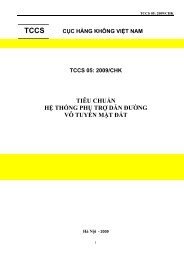
![TBD AC 01-001 Regulation Intro CAAV [A1]2009.fm](https://img.yumpu.com/45108462/1/190x245/tbd-ac-01-001-regulation-intro-caav-a12009fm.jpg?quality=85)
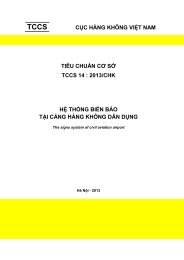
![AC 00-003 Safety Management System [0]2010.fm](https://img.yumpu.com/43642964/1/190x245/ac-00-003-safety-management-system-02010fm.jpg?quality=85)
![AC 18-001 DG Certification CAAV [A]2009E.fm](https://img.yumpu.com/43214114/1/190x245/ac-18-001-dg-certification-caav-a2009efm.jpg?quality=85)
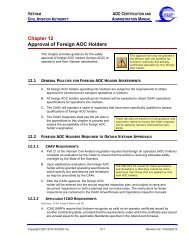


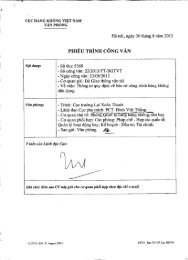
![AC 12-002 Add New Type [A]2010.fm](https://img.yumpu.com/38814666/1/190x245/ac-12-002-add-new-type-a2010fm.jpg?quality=85)
